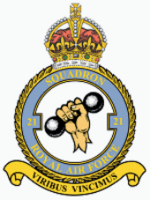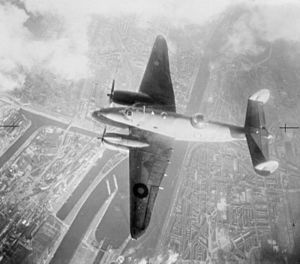No. 21 Squadron RAF facts for kids
Quick facts for kids No. 21 Squadron RAF |
|
|---|---|

No. 21 Squadron badge
|
|
| Active | 23 July 1915 – October 1919 December 1935 – November 1947 21 September 1953 – 30 June 1957 1 October 1958 – 15 January 1959 1 May 1959 – 15 September 1967 3 February 1969 – 31 March 1979 |
| Country | |
| Branch | |
| Motto(s) | Latin: Viribus vincimus (By strength we conquer) |
| Insignia | |
| Squadron badge heraldry | A hand erased at the wrist, holding a dumb-bell. The dumb-bell was used as a badge by the squadron in 1917 and symbolises strength. |
No. 21 Squadron was a special group of pilots and planes in the Royal Air Force (RAF). It was first formed in 1915. The squadron served in many important events, including both World Wars. It was finally closed down in 1979.
One of their most famous missions was Operation Jericho in 1944. During this mission, their Mosquito planes broke open a prison in France. This allowed members of the French Resistance to escape.
Contents
History of No. 21 Squadron
World War One Service
No. 21 Squadron of the Royal Flying Corps started on July 23, 1915. They trained at Netheravon with Royal Aircraft Factory R.E.7 planes. After six months, they moved to France in January 1916.
Their main job was to fly reconnaissance missions. This means they would fly over enemy areas to gather information. They also used their R.E.7s as bombers. They were the first squadron to drop large 336-pound bombs.
In August 1916, they got new planes called Royal Aircraft Factory B.E.12s. These were used for bombing and fighting. In February 1917, they received R.E.8 planes. These planes were very good at helping artillery units.
During the Battle of Messines in June 1917, their spotting helped stop 72 German artillery units. Because of this, General Trenchard, the commander, called No. 21 "the best artillery squadron in France." After the war, the squadron was closed down in October 1919.
Light Bomber Missions
The squadron started again on December 3, 1935, at RAF Bircham Newton. They were a light bomber squadron with Hawker Hind biplane aircraft. They moved to several bases, including RAF Abbotsinch and RAF Lympne. By August 1938, they received more modern Bristol Blenheim planes.
When Second World War began, the squadron was getting new Blenheim IV planes. They mostly flew reconnaissance flights at first. In May 1940, during the Battle of France, they started attacking German forces. Their first mission was to bomb a bridge at Maastricht.
From June to October 1940, they operated from RAF Lossiemouth in Scotland. They attacked German ships and helped prevent an invasion. Later, they began regular low-level attacks on enemy ships.
In April 1941, some of their planes went to Malta. This mission was successful. Because of this, other squadrons from their group also went to Malta. At the end of 1941, No. 21 Squadron moved to Malta again. They attacked Italian ships and targets in Italy and Libya. Malta was under heavy attack, and the squadron faced many losses. They were closed down in Malta in March 1942.
A new No. 21 Squadron was formed on the same day at RAF Bodney. They still had Blenheims but soon got Lockheed Ventura planes. They were the first RAF squadron to use the Ventura. Their first mission with the Ventura was a low-level attack on railway lines in the Netherlands.
In December 1942, they took part in Operation Oyster. This was a big attack on the Philips factory in Eindhoven. The Ventura planes were not ideal for their missions. By October 1943, they were replaced with de Havilland Mosquito aircraft.
The squadron then started flying night raids over Europe. From late 1943, they focused on Operation Crossbow. This was a campaign to attack V-1 flying bomb sites. After the Normandy invasion in June 1944, their Mosquitoes flew night missions. They tried to slow down German troops moving to fight the invasion.
The squadron also performed precise daylight raids. This included Operation Jericho in February 1944. They also made a famous attack on the Gestapo (German secret police) headquarters in Aarhus, Denmark. Another important mission was Operation Carthage against the Gestapo headquarters in Copenhagen.
In February 1945, the squadron moved to bases in France. Then, in December 1945, they moved to RAF Gutersloh in Germany. They helped with the Nuremberg Trials by providing courier services. The squadron was closed down on November 7, 1947.
Jet Bombers and Transport
On September 21, 1953, the squadron was reformed at RAF Scampton. They became a bomber unit with English Electric Canberra jet planes. In May 1955, they moved to RAF Waddington. They were involved in many missions overseas, including the Suez Crisis in 1956. The squadron was closed down again on June 30, 1957.
No. 21 Squadron was reformed once more on October 1, 1958. This time, they used Canberra B6 planes to collect air samples. These samples helped with nuclear weapons testing. The squadron was closed down again on January 15, 1959.
On May 1, 1959, the squadron took on a completely new role. They became a light transport squadron at RAF Benson. They used Scottish Aviation Twin Pioneer planes. In September, they moved to Kenya, based at RAF Eastleigh. They supported the British Army and local police.
In June 1965, the squadron moved to Aden. They took over Twin Pioneers from another squadron. They also added Douglas Dakota and Hawker Siddeley Andover planes. When British forces left Aden, the squadron was closed down on September 9, 1967.
The squadron's final formation was on February 3, 1969. They were called the Western Communications Squadron. They provided transport for senior officers in the western UK. They used Devon and Pembroke planes. Due to defense cuts, the squadron was finally closed down on March 31, 1976.
Aircraft Used by No. 21 Squadron
Over its long history, No. 21 Squadron flew many different types of aircraft:
- 1915 – Royal Aircraft Factory R.E.7
- 1916 – Bristol Scout
- 1916 – Royal Aircraft Factory B.E.2c
- 1916 – Royal Aircraft Factory B.E.2e
- 1916 – Martinsyde G.100
- 1916 – Royal Aircraft Factory B.E.12
- 1917 – Royal Aircraft Factory R.E.8
- 1935 – Hawker Hind
- 1938 – Bristol Blenheim I
- 1939 – Bristol Blenheim IV
- 1942 – Lockheed Ventura I
- 1942 – Lockheed Ventura II
- 1943 – de Havilland Mosquito VI
- 1953 – English Electric Canberra B2
- 1958 – English Electric Canberra B6
- 1959 – Scottish Aviation Twin Pioneer CC1
- 1965 – Douglas Dakota
- 1967 – Hawker Siddeley Andover CC2
- 1969 – De Havilland Devon C2
- 1969 – Percival Pembroke C1
See also
- List of Royal Air Force aircraft squadrons


